Moydilliga/Modeligo
Houses within 10km of this house
Displaying 68 houses.
Houses within 10km of Moydilliga/Modeligo
Displaying 68 houses.
| House name | Description | |
|---|---|---|
| Aghern/Ahern House | Brabazon Esq was resident in the 1770s and 1780s. The home of Spotswood Bowles in the first half of the 19th century. The buildings were valued at £47+ in the early 1850s and held from the representatives of William Beamish. Spotswood died in 1864 and was succeeded by his son George who was in turn succeeded by his nephew Spotswood in 1886. Relatives of the Bowles owned this property until the 1970s. In 1942 the Irish Tourist Association Survey mentions the ruins of Aghern Castle in the grounds of Mrs. Spotswood Bowles property. Aghern was uninhabited for a time but has recently been restored. |

|
| Rockville | At the time of Griffith's Valuation occupied by Michael Mockler and held from the representatives of Matthew Hendly, the buildings were valued at £26. The Mocklers advertised the sale of their interest in July 1851 and July 1853. The sale rental records the lease of Rockville by Ferguson Hendley to the Reverend James Mockler for 3 lives in July 1841 and that £2,000 had been spent on the house. Caroline Bourke occupied a mansion house with 37 acres in the townland of Licklash in 1906. It was valued at £60. In the 1870s Michael Bourke of Lecklash owned 37 acres. This house later became a summer home of Sir Oswald Mosley. Also known as Isleclash House. |
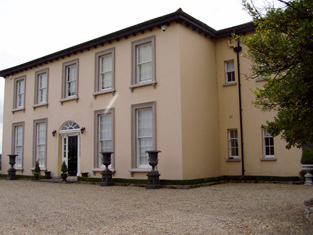
|
| Kilbarry (Castlelyons) | Hajba writes that a new house was built here in 1842 by the Wigmores. Robert Wigmore was resident in 1814, E[dward] Wigmore in 1837 and Henry Wigmore in the early 1850s when the buildings were valued at £23 and held in fee. In 1786, Wilson states that it was the residence of Hon. Mr. Moore. Later the home of the Kent and Waters families. Still extant and occupied. |

|
| Ballyglass/Ballyclough House | At the time of Griffith's Valuation Michael Cagney owned a house in the townland of Kilmagner valued at £24. Ballyglass House is marked on the first Ordnance Survey map in this townland. but the house at this location is named Ballyclough House on the 25-inch Ordnance map of the 1890s. Hajba identifies this house as Ballyclough House, Currabeha. Ballyclough was the residence of E. Creed in 1837. A house still exists at this location. | |
| Bellevue | Hajba writes that William Glissan sold this property to Thomas Dennehy of Clashmore, county Waterford. Bellevue was the home of Thomas Denehy in the first half of the 19th century, inhabited by him in 1814 and 1837 and by Daniel O'Neill in the early 1850s who held it from Thomas Denehy. The house was valued at £35. Later the home of the Dunleas, now a ruin. |
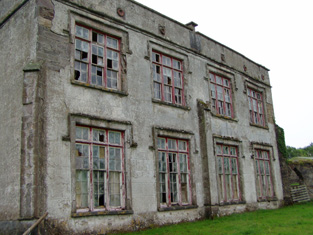
|
| Brook Lodge | The Lord Chancellor is given as the occupier of this house at the time of Griffith's Valuation. The Court of Chancery may have held the property from John Denehy at this time. The buildings were valued at £13. In 1942 the Irish Tourist Association Survey notes that it was once the residence of General Sir Thomas Dennehy and was then owned and occupied by James Scannell. A new house is now located on the site. | |
| Bettyville | The home of the Nason family in the early 19th century, occupied by Richard Nason in 1814 and 1837. By the early 1850s William Corbin was resident holding the house valued at £14.10 shillings from the representatives of Richard Nason. William Corbin was still living at Bettyville in the 1870s. This house is no longer in existence. | |
| Careysville | Careysville Castle, originally known as Ballymacpatrick Castle, was the seat of the Carey family from the late 17th century. In 1750 Careysville was occupied by John Carey and Peter Carey was resident in 1814. In 1837 Lewis refers to “the handsome modern mansion built on the site of Careysville castle” by E.K. Carey. Valued at £50 in the mid 19th century the Careys held this property in fee. Inherited by the Montgomerys of Killee and sold by them to the Duke of Devonshire in the mid 20th century. In 1942 the Irish Tourist Association Survey noted that the house was then unoccupied as Captain Montgomery had moved into a modern bungalow nearby. Careysville is now in use as a fishing lodge offering luxury accommodation. |

|
| Moorepark | A large Georgian house, the seat of the Earls of Mountcashell, extended in the 19th century. In 1786 Wilson describes it as "a superb and noble seat". It was held in fee at the time of Griffith's Valuation when it was valued at £87. Bought by the War Department in 1903 and accidentally burnt in 1908. In 1944 the Irish Tourist Association Survey noted that the remains of the kitchen were still visible then. Nothing remains of the original house and the site now belongs to Teagasc, the Agricultural and Food Development Authority. | |
| Glandulane House | Robert Briscoe had a house and flour mill in the townland of Clondulane North in the mid 19th century, which he held from the Earl of Mountcashel. The house was valued at £25.10 shillings and a flour mill at £96. Later the home of the Hallinans and the O'Donnells. A house is still extant at the site but the mill buildings are now ruinous. |

|
| Mountrivers | This house was a Hendley home in the 18th and 19th centuries, occupied by Mathers Hendley in 1814 and Mattias Hendley in 1837. Mattias C. Hendley was resident in the early 1850s. He held the property in fee and the buildings were valued at £27. The Hendleys contined to reside at Mountrivers until the 1930s and the house is still occupied. |
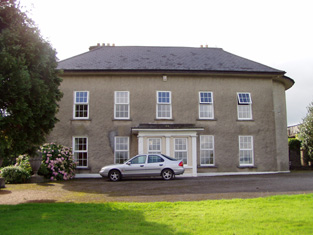
|
| Douglas House | Occupied by Henry Deece in 1837 and by Lady Mountcashell in the early 1850s. Held from the Earl of Mountcashel and valued at £16.10 shillings. Later the home of the Magniers and still a residence. |
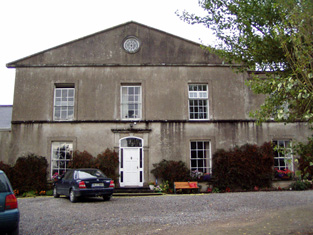
|
| Glansheskin | Occupied by John P. Pierse in the mid 19th century. He held the property valued at £19+ from the Earl of Mountcashel with a cornmill valued at £20. Later the property of the Cooke Collis family, this house is still occupied. | |
| Park House | Hajba writes that David Richard Pigot, Chief Baron of Ireland 1846-1873, was born at Park House in 1797. He was the son of Dr John Pigot and Margaret Nagle and married Catherine Paye [Page in DNB] of the nearby Araglin Mills. Th house was valued at £7.10 shillings in the early 1850s and was occupied by the Reverend James Daly, who held it from William Byrne. The Pigotts continued to own this property until at least the late 19th century. Occupied by the Howard family in the 20th century. The Irish Tourist Association Survey notes that it was also referred to as "Rock House". The survey also refers to another house owned by the Pigot family on the main street in Kilworth. | |
| Kilmurry | The house was built in the early 18th century and remained in the hands of the Grant family until sold to the Rosminian Order in the 1930s. In the 1940s the Irish Tourist Association surveyor was given to understand that the Grants still retained title to the property and were residing in South Africa. In the mid 19th century it was valued at £37 and held by Thomas St John Grant in fee. At the beginning of the 21st century this house was in a dilapidated state. |
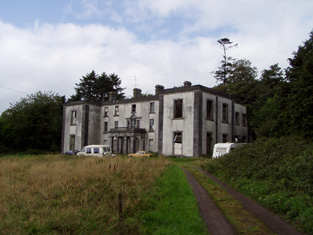
|
| Knockatrasnane | At the time of Griffith's Valuaiton, William Collis held in fee a house and offices valued at £14.10 shillings in this townland. The 1st edition Ordnance Survey map indicates a nursery at this site. The remains of the buildings are still extant. | |
| Castle Cooke | A house was located here from the 17th century. Originally home of the Cooke family it was altered and expanded in the succeeding centuries by the Collis family. William Collis was resident for much of the 19th century. The house was valued at £32 in the early 1850s and at £34 when occupied by Colonel William Cooke Collis in 1906. It was burnt in June 1921 during the War of Independence when it was the residence of Col. William Cooke-Collis. This house is no longer extant. | |
| Leitrim | Home of the Campion family for two centuries, sold by them in the 1870s to Major Victor Reeves of the Castle Kevin family. In 1943 the Irish Tourist Association Survey referred to it as the residence of David Nunan, formerly owned by the Campions, "in their day the house was thatched and much smaller". This 17th century house is still a residence. |

|
| Marshtown/Marston | Home of Richard Henry Gumbleton in the early 19th century and at the time of Griffith's Valuation when the buildings were valued at £12. 10 shillings. Advertised for sale in June 1854. Hajba writes that the Orpens built a much large house on the demesne in the 1860s which was burnt some time later. In 1906 Basil Orpin occupied a house valued at £55 at Marshtown. Buildings still exist at this site. An earlier Marshtown House, previous home of the Gumbletons, was located over the border in county Waterford. | |
| Araglin Cottage | Located on the bank of the Araglin River and built for Robert Viscount Kingsborough, later 4th Earl of Kingston, this was probably the summer residence recently erected by the Honourable Robert King in the parish of Templemologga, referred to by Lewis in 1837. It was offered for sale in July 1851 with 3,951 acres held by the Earl in the barony of Condons and Clangibbon. Sold to the Morlands who leased it as a fishing lodge, this house is now a family home. In the 1870s John Sherlock of Aroglin Cottage, Kilworth, was recorded as the owner of 183 acres in county Cork. |

|
| Ballyvolane | Hajba writes that Ballyvolane was bought by Sir Richard Pyne of Waterpark, Lord Chief Justice of Ireland, from the Coppingers in the early 18th century. It remained in the possession of the Pyne family until the mid 20th century and is still occcupied. Valued at £44 at the time of Griffith's Valuation, the house was occupied by Jasper Pine who held it from Thomas, George and Henry Walker. By 1906 the mansion house at Ballyvolane was valued at £70+ and occupied by George M.Pyne. |

|
| Ballyrobert | Hajba writes that Michael Mackay built a house beside the ruined castle of Ballyrobert in the 1820s and he is recorded as resident there by Lewis in 1837. In the early 1850s the house was valued at £23, occupied by Michael Mackay and held from John Peard. Michael J. Mackey occupied the house in 1906. This house no longer exists. | |
| Coole Abbey | This house was the home of a branch of the Peard family until the early 20th century and is still inhabited. It was occupied by Richard Peard in 1814 and by Henry Hawk Peard in 1837. He was still resident in the early 1850s and held the house valued at £36 from James H. Smith Barry. By the end of the 19th century Orr McCausland was the owner of Coole Abbey. |
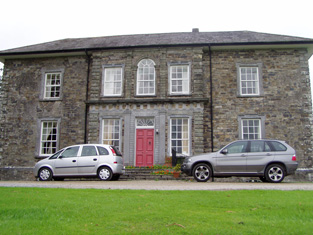
|
| Belvidere | This house was unoccupied in 1814. Mrs Maria Peard was the occupier in the mid 19th century holding the property from Henry Peard, it was valued at £15.12 shillings. Hajba writes that the Peards sold the estate to the Pope family who occupied the house until the early 20th century. |
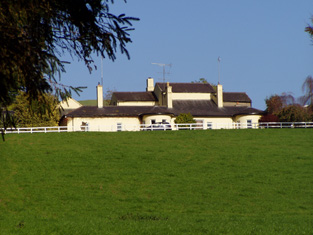
|
| Carrigeen Hall | In 1786, Wilson refers to "Carrygeen" as the seat of Mr. Peard. Hajba writes that this house was the home of Peard Harrison Peard, son of Richard Peard of Coole Abbey and father of Richard Frederick Peard of Belvidere and Henry Peard of Carrigeen. Later the home of the Green and O'Grady families, now demolished. | |
| Sun Lodge | Sun Lodge is marked on the first Ordnance Survey map and was occupied by Denis Hanan in the mid 19th century and held from Henry Peard. It was valued at £30+. Hanan's interest was advertised for sale in 1870. Hajba records various other occupants and this house is still occupied and well maintained. |

|
| Castleview | Castleview was the home of the Gumbleton family held from Henry Peard in the mid 19th century and valued at £68.15 shillings. The house remained in Gumbleton possession until the early 20th century but is now demolished. Bence Jones lists this house under the name Glynnatore and writes that it was built in 1791 by R. W. Gumbleton. In 1894 Slater notes Glenatore as the seat of Mrs. Gumbleton. | |
| Waterpark | Originally a Pyne residence which later passed through marriage to the Cavendishes. In 1786 Wlson refers to "the ruins of Water Park, the seat of the late Lord Chief Justice Pine". Hajba writes that other occupants were the Watkins and Drew families. There was no house of more than £2.10 shillings valuation in this townland, held by George Walker, at the time of Griffith's Valuation. | |
| Kilcor Castle | The home of the O'Brien family in the 18th and 19th centuries, sold by them in the mid 19th century. Cornelius O'Brien was the occupant in 1837 and at the time of Griffith's Valuation. He held the house valued at £17.15 shillings from James Reid. Kilcor was bought by Francis Doyne Dwyer and later passed to the Phipps family through marriage. In the 1940s the Irish Tourist Association Survey reported that it was the residence of Captain H. Phipps. |
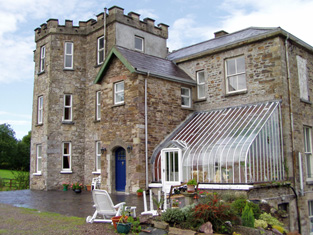
|
| Mohera | Hajba writes that Michael Mackay was recorded as resident here in 1824. By 1837 John O'Sullivan was resident and was still the occupier at the time of Griffith's Valuation. The buildings were then valued at £14 and the property was held from Major General Conyers. Home of the McAuliffes in the 20th century. |

|
| Rathbarry Cottage | Rathbarry Cottage was occupied by Major William Love Peard at the time of Griffith's Valuation. The property was held from the Reverend R. Gumbleton and the buildings were valued at £11. Some ruined walls remain at the site. | |
| Towermore | The home of Mrs Maria Oliver in 1837 but leased to Frederick C. Hayes in the early 1850s. The house was valued at £45. Maria was the widow of Charles S. Oliver of Inchera and a daughter of A. Morris of Dunkettle. A. Morris Oliver is recorded as a subscriber to Lewis ''Topographical Dictionary'' published in 1837 but is not mentioned in Burkes. Earlier, in 1786, Wilson refers to Tormore as the seat of Mr. Connor. This house was not occupied at the end of the 20th century although still extant. | |
| High Park | Occupied by the Reverend J. W. Edgar in 1837 and by Bridget Hogan in the mid 19th century, valued at £12+ and held from William Coppinger. This house no longer exists. | |
| Newtown | Newtown House was inherited by the Nasons through marriage with a Harrison heiress in 1716. It continued to be the main seat of one branch of the Nason family until the end of the 19th century. Still in Nason occupation in 1906 when the buildings were valued at £13. Only some ruined walls now remain. | |
| Mount Prospect | A Bowles family home, occupied by George Bowles third son of Robert Bowles of Springfield and father of Spotswood Bowles of Ahern. George was resident in 1814 and his widow was living there in 1837. His son George was resident at the time of Griffith's Valuation holding the property from Minor Cormack. The buildings were valued at £28+. Later the residence of Lieutenant Colonel George Eyre Massy [son of Hugh]. |

|
| Ballymacsimon | A house located on the Devonshire estate and occupied by John Kirby in the mid 19th century. The buildings were valued at £25. William Kirby held 2 townlands in the parish of Aghera at the time of Griffith's Valuation. Home of the Collins family in the mid 20th century and still inhabited. | |
| Booladurragha South | William O'Neill was occupying a house in this townland at the time of Griffith's Valuation, the buildings were valued at £15+ and the property was held from the Duke of Devonshire. The Duke is given as the occupier of this house in 1906. A house still exists at this site. Boulta House now functions as a guest house. |
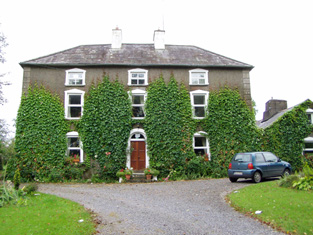
|
| Bride Park | Hajba writes that the Reverend Stephen Rolleston built this house in the 1770s. In 1814 it was inhabited by the Reverend Spread and in the mid 19th century by Thomas Power who held it from Mrs Elina Greaves and others. The buildings were valued at £20+. Bride Park remained the home of the Power family until the early 20th century. This house has recently been renovated and restored. |

|
| Carrigmore | Richard Power was resident here in 1814 and Edward Morragh in the mid 19th century. Morragh held the property from the Duke of Devonshire and the buildings were valued at £18+. Later the home of the Cronin family. Hajba writes that this house has been unoccupied since 1990. | |
| Thornhill | A Nason home, first occupied by John William Washington Nason. His widow Mrs Barbara Nason is recorded as resident at the time of Griffith's Valuation. Valued at £18.11 shillings the house was held from the Duke of Devonshire. The Nason family continued to live here until the mid 20th century. The house is still an occupied residence. | |
| Killavarilly | At the time of Griffith's Valuation John O'Neill, a doctor, held a house valued at £25+ and 350 acres from the Duke of Devonshire at Killavarilly. A house is still located at this site. | |
| Lisnabrin | A 3 storey 18th century house built by the Crokers on property inherited through marriage with the Coppingers in the 17th century. In the mid 19th century occupied by Edward Croker junior, son of Walter, the house was valued at £33+ in the early 1850s. Edward Croker died in 1901and Letitia C.C. Croker is recorded as the occupier in 1906. The property later passed to a relative Captain Walter A. Carew. The house was a hotel for a short time in the mid 20th century but is once more a family home. |

|
| Kilmacow | Located on the Devonshire estate, on the Cork/Waterford border, Kilmacow was occupied by John Boyce in 1814 and by William John Day in the early 1850s. The buildings were valued at £12. Bought by John Murphy of Tallow in the late 19th century and still extant. |
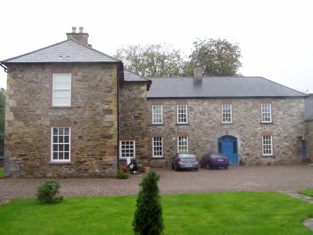
|
| Mogeely House | A house on the Devonshire estate, occupied by Charles H. Walsh in the mid 19th century and valued at £25.18 shillings. Later the home of the Des Barres and Kent families. Slater refers to it as the seat of Lt-Col. Des Barres in 1894. Still a family residence. It is labelled Mogeely Castle on the 1st edition Ordnance Survey map but as Mogeely House on the later editions, |
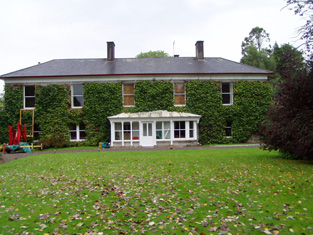
|
| Lisnabrin Lodge | Occupied by Thomas Carew in 1837 and by Sands Bellis who held the house and 28 acres from Thomas Carew in the mid 19th century. The buildings were valued at £36+. This house is extant, occupied and well maintained. |

|
| Curraglass House | Part of the Lysaght estate from the mid 18th century, W. and L. Giles are recorded at Curraglass in 1814. Earlier, in 1786, Wilson refers to it as the seat of Mr. Bonwell. By 1837 W. Gumbleton was resident and his widow Mrs Georgina Gumbleton occupied the house in the early 1850s. It was valued at £58+. Hajba writes that she was the last occupant of the house which is now demolished. | |
| Frankfort | This was a Woodley home, occupied by F. Woodley in 1837 and leased to Robert Wigmore in the early 1850s when the house was valued at £20+. The house was occupied until the 1970s but is now a ruin. |

|
| Templevally | The home of the O'Mahony family in the 19th century, occupied by William O'Mahoney at the time of Griffith's Valuation, valued at £26+ and held from Cooper Penrose. Late this house was home to the Condons. The original house is demolished and a later house is now inhabited. |
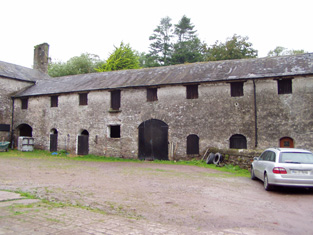
|
| Woodview | Woodview was the home of the Reverend George Nason in 1837 and in the early 1850s was occupied by his son Charles Nason who held the property from Major Edward Croker [Lisfinny]. The buildings were valued at £13+. This house is still a family residence. | |
| Castlelyons House | Situated on 2 acres in the centre of the town of Castlelyons this house was in the possession of the related clerical families of Browne and Ryder in the 18th and 19th centuries. Occupied by the Reverend Joshua B. Ryder in the mid 19th century. He held the property valued at £30 from Samuel Perrott. Still valued at £30 this house was occupied by the representatives of Andrew W. Ryder in 1906. |

|
| Berry Hill | The National Inventory of Architectural Heritage states that this house dating from circa 1700 was a dower house for the Barrymore family of Castlelyons Castle. By the mid 19th century it was in the possession of the Perrott family and occupied by the Reverend Philip Berry who held the buildings valued at £21 with 15 acres. This house is still occupied. |
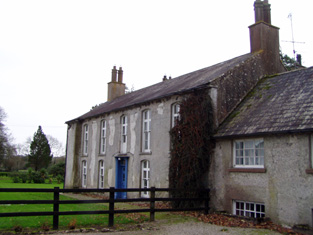
|
| Ballymartin House | Francis Campion, MD, was leasing this property from the Cavendish estate in 1851 when it was valued at £16. It is present but not named on the 1st edition Ordnance Survey Map but is named Ballymartin House on the later 25-inch map. Brady indicates that the present house is of early nineteenth century date. It is still extant and occupied. |

|
| Ballygally House | Ballygally House was the property of Nelson T. Foley in 1851 when it was vacant and valued at £27 10s. In 1837 Lewis refers to it as "the occasional residence of G. Holmes Jackson". It is still extant and occupied. |

|
| Flowerhill House (Waterford) | Flowerhill was leased by Nelson T. Foley to Barry Drew in 1851. Lewis also refers to it as the seat of B. Drew, describing it as " a beautiful residence in the cottage style". The house is no longer extant. | |
| Elgin Cottage | In 1851 this property was leased by Georgiana Gumbleton to Edmund Barry when it was valued at £10. It was built after the 1st edition Ordnance map and is labelled Elgin Cottage on the 25-inch edition of the 1890s. There is still an extant house at the site. | |
| Marshtown House | Held in fee by R.H. Gumbleton at the time of Griffith's Valuation, when it was valued at £8 10s. The property is labelled Marshtown House on the 1st editon Ordnance Map but is not labelled on the later 25-inch edition. Marston House (W950987), in the adjacent townland of Marshtown, is shown on the 25-inch map of the 1890s but there is no trace remaining. | |
| Cloonbeg | A property described as offices, the property of R.H. Gumbleton, was valued at £15 5s at the time of Griffith's Valuation. In 1906 this property was owned by Basil Orpin with a valuation of £16. Some of the buildings still remain at the site. | |
| Fortwilliam House (Waterford) | In 1851 J.B. Gumbleton held this property in fee when it was valued at £47 10s. Lewis also refers to it as his seat in 1837 when he describes it as " a handsome demesne with a new house being erected". The ITA survey noted it as the residence of Mr. P. Dunne in 1942. Fortwilliam is still extant and occupied. In 2024 it was offered for sale. |
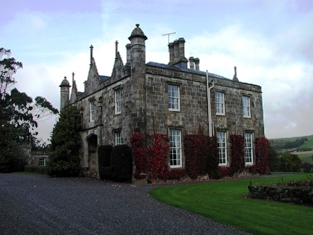
|
| Ballyduff Castle Farm | Described as Ballyduff Castle (in ruins) on the 1st edition Ordnance Survey map, these buildings were valued at £11 15s at the time of Griffith's Valuation. They were being leased by Edward Walsh from the Musgrave estate. The National Inventory of Architectural Heritage suggests the house was built c.1825. The ruined fortified house at the site dates from the early seventeenth century. |
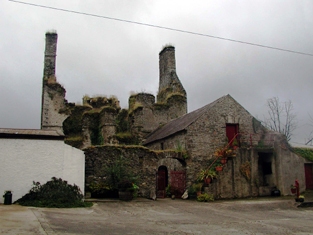
|
| Glenmore House (Lismore) | At the time of Griffith's Valuation, Thomas Boyce was leasing this property to Richard Cliffe, when it was valued at £24. A very substantial farmyard is labelled at this site on the 1st edition Ordnance Survey Map. It is labelled Glenmore House on the later 25-inch edition. It is still extant and occupied. |
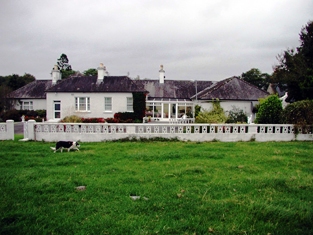
|
| Ballysaggartmore House | Held in fee by Arthur Ussher at the time of Griffith's Valuation, when it was valued at £68. Lewis refers to it as the seat of A Keily in 1837 when he describes the demesne as "ample and tastefully planned". Local sources suggest Arthur Keily-Ussher commenced building a lavish castle in 1850. The extravagent entrance depleted his funds and the castle was never completed. It was later purchased by the Woodruffe family. In 1906 it was the property of Richard Woodroffe and valued at £68. The house was burned in 1922 and demolished in the 1930s. The elaborate towers are still extant and part of the demesne is a Forestry Service amenity area. |
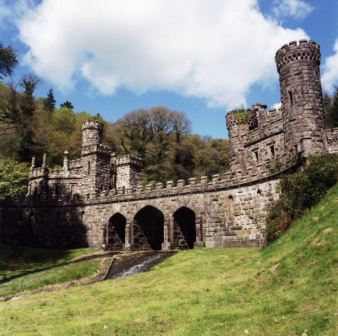
|
| Deerpark (Lismore) | Arthur Ussher held in fee a farmhouse and farmyard at Deerpark, valued at £16 10s, in 1851. Extensive farm buildings still exist at the site. | |
| Glencairn Abbey | Glencairn was held in fee by Jervis (Gervase) P. Bushe in 1851 when it was valued at £51. The property had previously been part of a Gumbleton estate, firstly as Ballygarron Castle and later, in the eighteenth century, a house known as Castlerichard. Wilson records it under this name in 1786, describing it as "the beautiful seat of Mr. Gumbleton". Its name was changed to Glencairn Abbey c.1814 when it was substantially altered and extended by Richard Edward Gumbleton. Following his death in 1819 it passed to his brother-in-law Henry A. Bushe, in whose family it remained until the 1880s. It became a Power property following the marriage of Frances Bushe and Ambrose Power of Barrettstown, county Tipperary. It was owned by the representatives of Gervase Bushe in 1906 and valued at £31. The Powers continued to occupy Glencairn until 1922. It was purchased by the Cistercian Order in 1926 and has been home to the Cistercian Sisters since. The substantial steward's house and farmyard [X009983] is now the home of the Barry family who provide guest accommodation there. In 1906 it was also held by Bushe's representatives and valued at £12. |
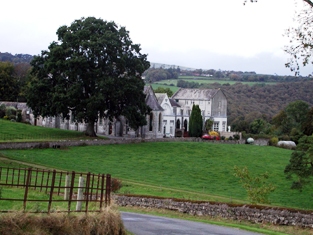
|
| Lisfinny House | Major Edward Croker was leasing this house from the Devonshire estate in 1851 when it was valued at £23. Lewis also recorded it as his residence in 1837 when he noted that "the ancient castle, built by the Earl of Desmond, has been converted into a handsome residence". It is still extant and occupied. |
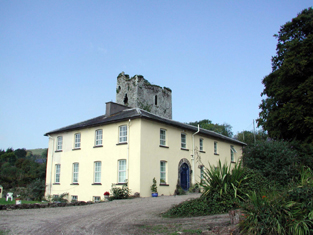
|
| Mocollop Castle | Mocollop Castle was in ruins by the time of Griffith's Valuation, though buildings at the site were valued at £31. They were held in fee by Captain James Barry. In 1786, Wilson refers to it as the seat of Dr. Drew. In 1906 the buildings at this location were in the possession of Henry Drew, MD, and valued at £32. The National Inventory of Architectural Heritage reports that the buildings there were in ruins in the early part of the 21st century. |

|
| Glenbeg House (Lismore) | In 1851 Glenbeg House was owned by Thomas Foley but was vacant. It was valued at £23 10s at that time. In 1837 Lewis refers to it as the seat of G. Bennett Jackson. The original house dates from the mid-sveenteenth century though it was renovated in the nineteenth and twentieth centuries. Smith, writing in 1774, refers to it as the seat of Mr. John Jackson. Sadleir, referring to Rowland Jackson in 1775, notes that he was "of Glanbeg". Brady notes that the Jacksons were employed by the first Earl of Cork in the early seventeenth century. Described as "an ordinary farmhouse" in the ITA Survey in 1942. It is still extant and occupied. |

|
| Roseville (Tallow) | Leased by William Parker from the Devonshire estate at the time of Griffith's Valuation when the buildings were valued at £20 10s. It is also recorded as his address in the 1870s. Roseville is still extant and occupied. |

|
| Castle Lyons | Wilson, writing in 176, refers to the accidental burning of the seat of the Earls of Barrymore. "The mansion house, with the furniture and a valuable collection of pictures, were entirely destroyed by an accidental fire". Some ruins remain at the site. A dower house, built by the Barry family towards the end of the 18th century, is still extant and known as Berryhill. . |

